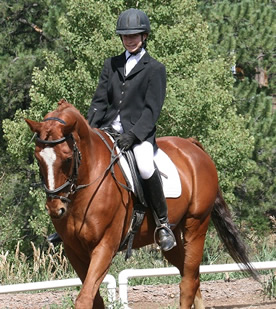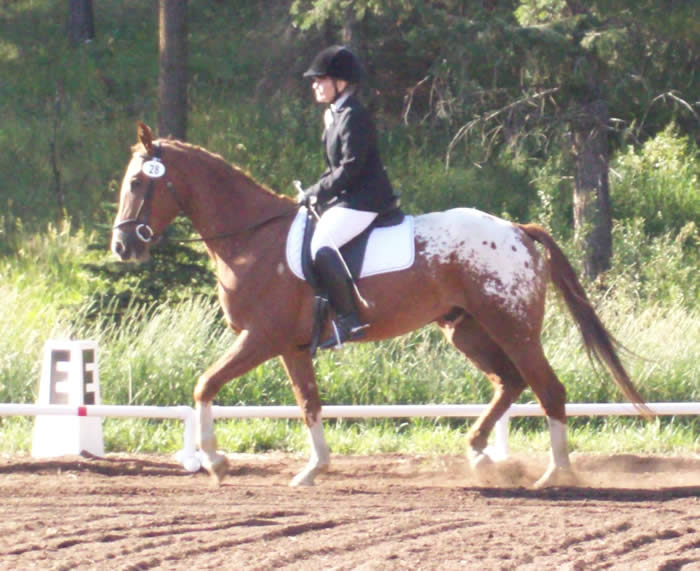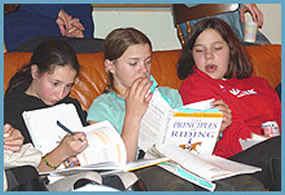|
||

Call or e-mail for more
information 12889 S. Parker Ave. Credit Cards Accepted Receive an Alert when a new offering is scheduled: |
Serving the Evergreen, Conifer and Bailey, Colorado, area communities. Dressage lessons make a great gift. Call 303-838-5086 or e-mail info@CentaurRising.org for more details. Dressage in French simply means “training”. It is the educated and classical form of horseback riding that has been passed down from one “Master” to the next since Greek times. Dressage training respects the individual and natural qualities of the horse. It requires more from the rider than other disciplines – asking that the rider be symmetrical, supple and balanced in his own body, and that he learn to feel what is happening in various parts of the horse’s body.
The sport of dressage sets forth a clearly defined international “recipe book” for horse training. Dressage horses are exhibited through nine distinct levels, each of which roughly represents a year of training. Each level has its own standards, both in terms of what maneuvers the horse is supposed to be able to do and how training progress to that point is evaluated. Each level, like each step of the training pyramid, builds upon the last. In many United States Equestrian Federation (USEF)-recognized breed disciplines, a horse can be shown under saddle after only a few months of training. This may require that “artificial” devices be used to accomplish training, e.g. draw reins, tie downs. Such shortcuts may result in the desired "look" but it will be at the expense of suppleness, elasticity and natural expressiveness. These are the hallmarks of a correctly trained dressage horse. (See three-year-old Grandbeau - below right - in his first dressage show after four weeks of training.) There are many other “quick fixes” to training
that do not result Dressage aficionados devote much study to the development of the horse. Goals and standards are universal. Results are unmistakable. Yet the exact means are not easily communicated nor comprehended. Even if the means are understood intellectually, it is not easy for the human body to execute what is required. Hence dressage is both eminently challenging and humbling. No human can possibly learn all there is to learn about correct training in one lifetime! Why should any of this matter to you? Because dressage is training. Every time a human comes into contact with a horse, training – for the better or for the worse – occurs. Dressage provides the tools through which any horse can improve. At Centaur Rising, we do not just teach people to survive on a horse or to “push the right buttons”. We give every rider the credit that he/she can learn how to train a horse, why each movement is important and how to feel whether progress is being made in the horse’s body. We teach people to recognize the hallmarks of a well-trained horse. We teach people how to ultimately train their own horse. We give them the tools to train, not just one, but a lifetime of horses. This is why correct riding and training is so integrally tied to horse welfare and to youth development – and to compassion. We teach that there are alternatives to abuse and/or to discarding the horse when he fails to live up to our own selfish (and sometimes unreasonable) expectations. We teach humans the humbling lesson that it is our responsibility as humans to render the horse more companionable.
Some of the products of this philosophy can be seen in the success stories of the founders of CR. These riders did not just learn to ride a well-trained horse. They were taught how to develop the horse into what he is today. That’s why their accomplishments are all the more noteworthy. Please join us in our mission to further classical and correct horsemanship! Your financial support is welcomed and gratefully appreciated. |
Centaur Rising, a 501(c)(3) nonprofit organization, is located 20 minutes southwest of metro Denver near the Rocky Mountain foothill communities of Conifer, Bailey, Evergreen, Morrison, Golden and Pine, CO.
Thank you!
Unsubscribe | Privacy Policy | Home

 Dressage is based upon the methodical training of the horse. It
incorporates expectations of rhythm, suppleness, contact, impulsion,
straightness and collection. These elements compose the “Pyramid
of Training”, originally documented by the German cavalry
in the 1800’s, now acknowledged and accepted worldwide.
Dressage is based upon the methodical training of the horse. It
incorporates expectations of rhythm, suppleness, contact, impulsion,
straightness and collection. These elements compose the “Pyramid
of Training”, originally documented by the German cavalry
in the 1800’s, now acknowledged and accepted worldwide. in symmetry, flexibility, suspension and power. Yet the
result of dressage equestrian training is unmistakable. It
is a horse that responds without hesitation to the rider’s
seemingly invisible aids. To the rider, the horse obeys
as though the rider’s brain were in fact directing each limb, back and neck of the horse.
in symmetry, flexibility, suspension and power. Yet the
result of dressage equestrian training is unmistakable. It
is a horse that responds without hesitation to the rider’s
seemingly invisible aids. To the rider, the horse obeys
as though the rider’s brain were in fact directing each limb, back and neck of the horse. Dressage is the correct foundation for all disciplines, all
breeds, horses of all ages and temperaments. It is not
a quick fix, a fad or something easily marketed and sold in a
package. Dressage, like basic horse care,
takes time. It takes commitment. It takes consistency
and personal responsibility. It takes focus on the "here and now". It takes educated understanding. These
are human qualities lacking in today’s society.
Dressage is the correct foundation for all disciplines, all
breeds, horses of all ages and temperaments. It is not
a quick fix, a fad or something easily marketed and sold in a
package. Dressage, like basic horse care,
takes time. It takes commitment. It takes consistency
and personal responsibility. It takes focus on the "here and now". It takes educated understanding. These
are human qualities lacking in today’s society.